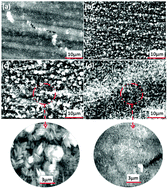In situ growth of a CaAl-NO3−-layered double hydroxide film directly on an aluminum alloy for corrosion resistance
Abstract
In this study, a calcium–aluminum-layered double hydroxide (CaAl-LDH) thin film was grown on an AA6082 aluminum alloy, for the very first time, by using a facile in situ growth method in an effort to investigate the CaAl-LDH structural geometry and corresponding corrosion resistance properties. The structure and surface morphologies of the CaAl-LDH thin film were studied using a scanning electron microscope (SEM) equipped with an EDS detector, a transmission electron microscope (TEM), an X-ray diffractometer (XRD), and a Fourier transform infrared spectrometer (FT-IR), while the electron impendence spectra (EIS) and potentiodynamic curves were recorded to understand the LDH anticorrosion behavior. The findings demonstrated that thin, well-developed CaAl-LDH coatings with different surface morphologies can be prepared with eminent corrosion resistance properties. Specifically, the CaAl-LDH thin film synthesized at 140 °C–24 h synthetic conditions showed a large impedance modulus of 7.3 Ω cm2 at 0.01 Hz (|Z|f = 0.01 Hz), along with a low corrosion current density (Icorr) of 0.0007 μA cm−2, while a vertically orientated rod like structure with a uniform surface morphology was observed.

- This article is part of the themed collection: Inorganic Porous and Layered Material


 Please wait while we load your content...
Please wait while we load your content...